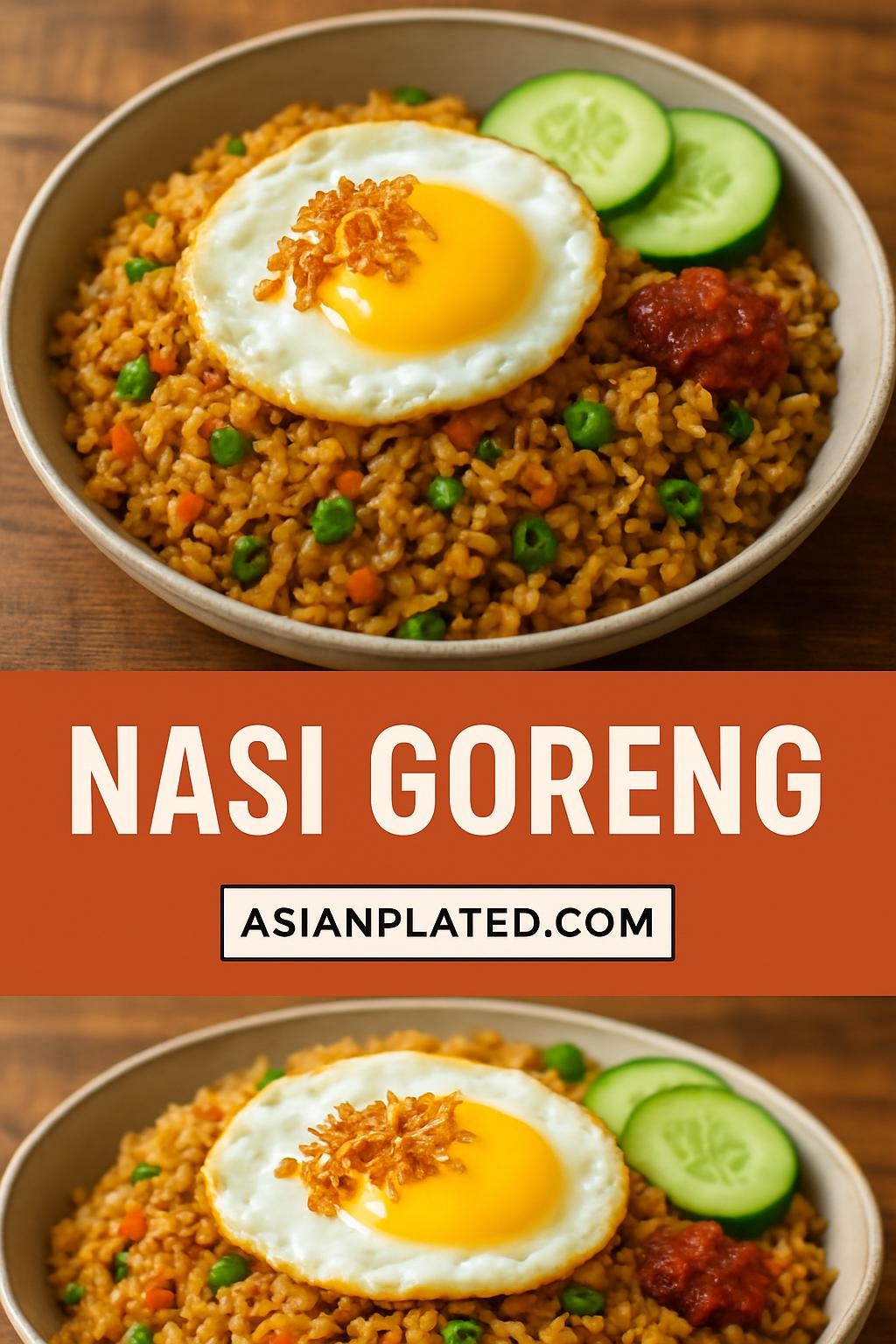Nasi Goreng, or Indonesian fried rice, is a vibrant and flavorful dish that encapsulates the essence of Southeast Asian cuisine. This one-pan wonder is not only a staple in Indonesian households but also a beloved comfort food around the world. With its tantalizing blend of spices, colorful vegetables, and optional protein additions, nasi goreng is the perfect dish for any meal of the day. It’s an easy, quick, and satisfying recipe that never fails to impress, making it a must-try for anyone looking to elevate their culinary skills.

Why You Will Love This Recipe
You’ll fall in love with this nasi goreng not just for its rich, savory flavor, but also for its simplicity and versatility. This dish is a fantastic way to use up leftover rice and vegetables, making it a budget-friendly option for busy weeknights. With a zesty kick from soy sauce and sambal oelek, combined with the umami from the proteins of your choice, each bite bursts with flavor. Plus, it accommodates various diets, allowing for vegetarian, vegan, or meat-lover adaptations. Easy to whip up in under 30 minutes, nasi goreng is a quick fix that doesn’t compromise on taste.
Tips and Tricks
To make your nasi goreng truly exceptional, here are some handy tips:
- Use Day-Old Rice: Freshly cooked rice can be too moist, resulting in a clumpy dish. Day-old rice has the right amount of dryness and firmness.
- High Heat is Key: Cook on high heat to achieve that desirable wok hei (breath of the wok) flavor. This also helps in getting a nice char on the ingredients.
- Prep Your Ingredients First: To ensure a seamless cooking experience, chop and measure all your ingredients before you start cooking. This will save you time and keep the process smooth.
- Experiment with Proteins: Chicken, shrimp, or tofu can all work well. Just be sure to cook proteins separately before adding them back to the dish to ensure even cooking.
Make Ahead Tips
For the busy cook or meal prepper, nasi goreng can be tailored to fit your schedule:
- Rice: Cook your rice a day ahead and store it in the refrigerator. It will firm up and be perfect for frying the next day.
- Chop Veggies: Prep your vegetables and proteins a day in advance. Store them in airtight containers in the fridge.
- Sauce Mix: Combine soy sauce, sambal oelek, and any other sauces in advance for quick access.

Recipe Variations
Nasi goreng is highly adaptable, and you can easily customize it:
- Vegetarian/Vegan: Use tofu or tempeh instead of meat, and opt for vegan sauces.
- Different Proteins: Swap shrimp for chicken, or mix in some cooked beef or pork.
- Add Fruits: Try adding pineapple or mango for a sweet twist.
- Spice Levels: Adjust the sambal oelek to make it as spicy or mild as you prefer.
How to Serve
Serving nasi goreng is all about presentation:
- Plating: Serve it in a bowl or on a plate, mounding the rice high for visual appeal.
- Garnishes: Top with sliced cucumbers, tomatoes, a fried egg, or crispy fried shallots for added flavor and texture.
- Accompaniments: A side of pickled vegetables or prawn crackers can add a delightful crunch.

Pairing Suggestions
Enhance your meal with these pairing suggestions:
- Drinks: A chilled glass of iced tea or a light lager pairs beautifully with the flavors of nasi goreng. For something stronger, consider a mojito or a light white wine.
- Sides: Serve with a simple cucumber salad or steamed vegetables to balance the richness of the dish.
- Desserts: A refreshing fruit salad or a coconut sorbet can cleanse the palate after this savory meal.
How to Store
Leftovers can be stored easily:
- Refrigerate: Place leftover nasi goreng in an airtight container and store in the fridge for up to 3 days.
- Freeze: For longer storage, freeze portions in airtight containers for up to a month.
- Reheat: To reheat, either microwave or stir-fry in a pan with a splash of water or oil to bring the dish back to life.
Equipment Needed
While you can cook nasi goreng with basic kitchen tools, the following equipment can enhance your cooking experience:
- Wok or Large Skillet: Ideal for high-heat cooking and achieving that perfect stir-fry.
- Spatula: A wooden or silicone spatula is perfect for stirring and preventing scratches on your cookware.
- Measuring Cups and Spoons: For precise ingredient measurement, especially for sauces.

Dietary Adaptations
Nasi goreng can be customized for various dietary needs:
- Vegan: Replace eggs with tofu scramble and ensure sauces are vegan-friendly.
- Gluten-Free: Use tamari instead of soy sauce to keep it gluten-free.
- Nut-Free: Ensure that any sauces or toppings do not contain nuts, and avoid peanut oil if you’re cooking at home.
Seasonal Adaptations
Tailoring nasi goreng to seasonal ingredients can elevate the dish:
- Spring: Add snap peas and green onions for a fresh crunch.
- Summer: Incorporate vibrant bell peppers and zucchini.
- Fall: Use root vegetables like carrots and sweet potatoes.
- Winter: Add hearty greens like bok choy or kale to the mix.
Recipe FAQs
- Can I use brown rice instead of white rice? Yes, though it will change the texture and cook time slightly.
- How do I adjust the spice level? Start with a smaller amount of sambal oelek and taste as you go.
- Can I make this dish vegetarian? Absolutely! Just substitute any meat with tofu or tempeh.
- How long does it take to cook? The entire process takes about 30 minutes, including prep.
Nasi Goreng

Nasi Goreng, or Indonesian fried rice, is a vibrant and flavorful dish that encapsulates the essence of Southeast Asian cuisine.
Ingredients
- 3 cups cooked and cooled jasmine rice (preferably day-old)
- 2 tablespoons vegetable oil
- 2 cloves garlic, minced
- 1 shallot, thinly sliced
- 1 cup mixed vegetables (carrots, peas, corn)
- 2 eggs (or tofu for vegan version), beaten
- 3 tablespoons soy sauce
- 1 tablespoon sambal oelek (adjust to taste)
- Salt and pepper to taste
- Sliced green onions and fried shallots for garnish
Instructions
- Heat the vegetable oil in a large wok or skillet over high heat.
- Add the minced garlic and sliced shallot. Sauté for about 30 seconds until fragrant.
- Toss in the mixed vegetables and stir-fry for 2-3 minutes until they're tender.
- Push the vegetables to one side of the wok and pour the beaten eggs (or tofu) into the empty space, scrambling until cooked through.
- Add the cooled rice to the pan, breaking up any clumps. Mix everything well.
- Pour in the soy sauce and sambal oelek, stirring to combine. Season with salt and pepper as needed.
- Stir-fry for an additional 2-3 minutes until everything is heated through and well combined.
- Serve hot, garnished with sliced green onions and fried shallots.
Nutrition Information:
Yield: 4 Serving Size: 1Amount Per Serving: Calories: 281Total Fat: 10gSaturated Fat: 2gTrans Fat: 0gUnsaturated Fat: 7gCholesterol: 93mgSodium: 857mgCarbohydrates: 39gFiber: 2gSugar: 2gProtein: 8g
Asianplated.com, occasionally offers nutritional information for recipes contained on this site. This information is provided as a courtesy and is an estimate only. This information comes from online calculators. Although allchickenrecipes.com attempts to provide accurate nutritional information, these figures are only estimates.
Final Thoughts
Nasi goreng is more than just a meal; it’s a celebration of flavors and textures that brings joy to the table. Whether you’re enjoying it for breakfast, lunch, or dinner, this dish is versatile enough to suit any occasion. With the tips and tricks provided, you can easily create your own delicious version at home. So why not gather your ingredients and experience the delightful world of nasi goreng today? Happy cooking!


















